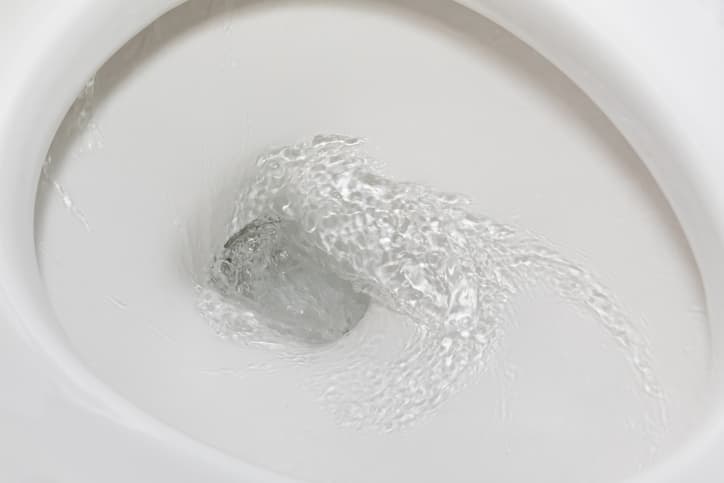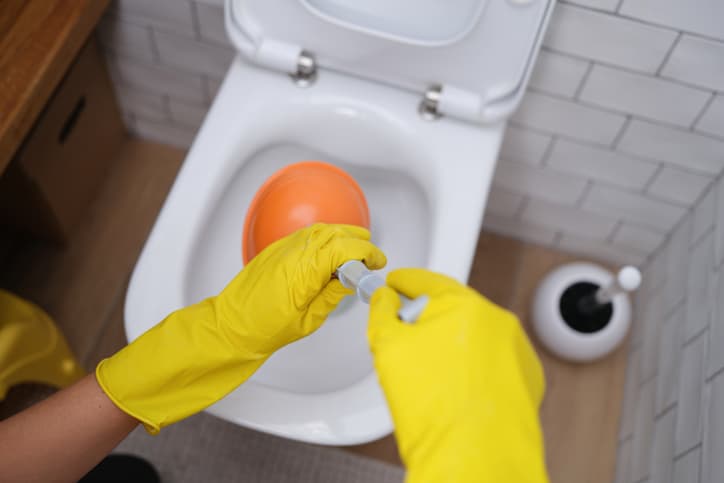We have all had to deal with a clogged toilet at some point. We flush the toilet and, just as the waste goes down the hole, it gets clogged. Then we watch in panic as the water continues to rise and potentially overflow onto the bathroom floor.
If the water does start overflowing from the toilet bowl, your first concern should be to contain the water. You can use towels to stop the water and prevent it from flowing all over the bathroom floor.
Once you have the water cleaned up, you can then worry about why the toilet is clogged in the first place. Most importantly, DO NOT flush the toilet again. This can cause more water to back up inside the bowl and overflow the toilet.
When you cannot wait to have a toilet clogged fixed, Larkin Plumbing is available 24/7 with our emergency plumbing services. Contact us now to schedule service.
Reasons Why Your Toilet Is Clogged
A variety of reasons can cause toilet clogs, such as:
- Using too much toilet paper can result in a clog.
- Flushing items down the toilet that are not meant to be flushed, such as paper towels, disposable diapers, kitty litter, baby wipes, condoms, and feminine hygiene products.
- Flushing small objects, toys, batteries, and other things that should never go in a toilet.
- Low water pressure that is insufficient to push waste down the sewer line and out of the house.
- Sewer line problems, like tree roots growing inside the sewer line.
- Septic tank problems when the septic tank is full and needs to be pumped out.
- A broken sewer line that prevents proper flow.
- Flushing food and pouring hot grease down the toilet drain.
How to Fix a Clogged Toilet
Step 1: Plunge the Toilet
The first step to unclogging a toilet is to grab a toilet plunger and use some good old-fashioned elbow grease. Ensure the bottom of the plunger fits tightly over the drain hole. You may need to plunge multiple times before the clog is removed.
If you notice the water seems to drain away, flush the toilet to see if the clog is removed. Before flushing, put some towels around the toilet in case the clog was not removed.
Step 2: Pour Hot Water Down the Toilet Drain
If plunging was unsuccessful, hot water could solve the problem. You should fill a big pot with water and heat it on the stove. However, don’t let the water boil. Boiling water is too hot to pour down the toilet drain and could crack your toilet bowl.
If you have a thermometer, you want the water to be at least 130 to 140 degrees Fahrenheit. If not, you could always run the hot water in your kitchen sink for a few minutes until it reaches the hottest point and then fill the pot with that instead.
Step 3: Use Baking Soda and Vinegar
Combining baking soda and vinegar creates a fizzing chemical reaction that can sometimes help remove toilet clogs. If the bowl is already to the rim, remove the water until it is at its normal level.
Next, pour one cup of baking soda directly into the toilet bowl drain. Then, pour one cup of vinegar down the drain. You should see bubbles in the drain when the vinegar interacts with the baking soda.
Allow the chemical reaction to work for at least half an hour. Lastly, pour hot water down the drain to see if the clog has been removed.
Step 4: Try Some Dish Soap
If the clog is still there, you can pour about one-quarter cup of dish soap into the toilet bowl. Use a high-quality dish detergent that helps fight grease. Wait about 15 to 20 minutes to allow the soap time to move down the drain line.
Next, pour a pot of hot water down the drain. Wait about an hour to see if the clog is gone. When the hot water combines with the dish soap, it acts as a lubricant that can help remove the clog.
Step 5: Use a Wet/Dry Vac
A wet/dry vacuum is different from your regular vacuum cleaner. They are designed to work with water and not get damaged. If you do not have one, you could consider renting one from a home improvement or hardware store.
There are two methods you can try. The first one is to use the wet/dry vac to remove the water from the toilet bowl. Then, wrap a towel around the hose to create a seal as you gently slide the hose into the drain line. The suction from the vacuum is powerful enough to suck up the clog if it is nearby.
The second method is to use the air outlet to attempt to remove the clog. Start by sucking up the water from the toilet bowl. Next, remove the hose from the air intake where it is currently connected and put it on the air outlet.
Wrap a towel around the hose, and slide the hose down the drain. Turn on the wet/dry vac and allow air to blow down the drain line. If you have a powerful enough wet/dry vac, it could break up the clog and clear the drain line.
Step 6: Call Your Local Plumber
If none of the previous steps worked to remove the clog, there could be a more serious plumbing problem. This is the time to bring in the professionals for assistance.
Related: How to Replace a Toilet Handle
What about toilet clog remover?
While pouring toilet clog remover down the toilet drain can be tempting, the hazardous chemicals could cause more harm than good. Furthermore, each of these products is formulated for different types of clogs. So, they may not even work and could damage your toilet drain line.
Benefits of Hiring a Local Plumber
One of the primary benefits of hiring a local plumber is they have the plumbing tools and equipment needed to remove toilet clogs quickly and easily. So, you don’t have to worry if you don’t have a plunger or a wet/dry vac.
Additionally, in the event the toilet is clogged due to low water pressure, a broken or damaged sewer line, or a septic problem, they have the training and expertise to fix the problem.
The Easy Way to Unclog a Toilet
Using the steps above should help resolve clogged toilet problems most of the time. However, when they do not, or you simply lack the tools and patience to remove the clog yourself, you can count on Larkin Plumbing, the most trusted plumber in Las Vegas, to resolve toilet clogs quickly and easily, day or night.
From toilet clogs and drain cleaning to septic system and sewer line problems, you can count on the plumbing experts at Larkin Plumbing. Contact us to schedule service today!



